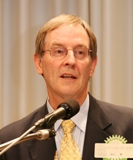��New Zealand in the World��
November 18, 2009
H. E. Mr. Ian Forbes Kennedy
New Zealand Ambassador
 ��New Zealand –the Country and Its People��
��New Zealand –the Country and Its People��
��Some 60 million years ago, during the Palaeozoic era, New Zealand lay beneath the sea as part of Gondwanaland. The earth's crust moved dramatically and New Zealand rose to the surface in its current form about 10 million years ago, becoming the youngest country in the world.
��According to Maori legend, the great Polynesian navigator Kupe discovered New Zealand during his epic voyage. Later on, estimated around 1350, numbers of Maori arrived in a Great Fleet of seven canoes across the vast South Pacific Ocean. Some time after that, the first European (Pakeha) settlers arrived in small sailing ships from England, Ireland, Scotland and Wales. They sought better life in New Zealand, away from the class-bound nature of Britain where economic and social strata pre-determined people��s fate.
��New Zealand Aspirations��
����No one New Zealander is quite like another, embodying the Kiwi ethos of intellectual curiosity, sense of adventure and will to explore new horizons. The following four New Zealanders are leaders we look up to and draw inspiration from.
��Sir Ernest Rutherford, born in 1871, is the Nobel prize-winning physicist. Renowned to be the father of modern nuclear physics, his down-to-earth country-boy upbringing led to his exceptional originality as a thinker.
��Sir Edmund Hillary, born in 1919, stunned the world by becoming the first mountaineer to climb Mount Everest in 1953. For all his achievements, he remained extremely humble.
��Bruce McLaren, born in 1937, was an exceptional racing car driver. During his short 32-year-life, he contributed both to the sport and racing car construction engineering.
��Peter Jackson, born in 1961, is one of the leading film-makers in the world, best known for his Academy Awards winning production of The Lord of the Rings.
��Virtual Distance��
��There are three factors defining virtual distance: physical distance (which is measurable), operational distance (day-to-day distractions that keep us from paying attention to one another), and affinity distance (things like value misalignments and lack of feeling interdependent upon one anther). Virtual distance determines the productivity and innovation of teams, sometimes far apart. Measured in terms of virtual distance, New Zealand and Japan are very close indeed.
��New Zealand/Japan Partnership��
��We need to connect with the rest of the world, in terms of economic benefits, cultural enrichment and international partnerships to address world issues of climate change and security.
��New Zealand is located on the rim of Asia-Pacific region, our greatest strategic asset, as Asia is likely to propel world economic growth for some time ahead. Our government, academics and business leaders identified Asia as the most important region for our future prosperity. Exports and tourism have grown steadily, thus making the virtual distance ever closer. New Zealand seeks to be part of the bi- and pluri-lateral trade links established throughout the Asia Pacific region.
��As for trade agreements, we have had the 26-year-Free Trade Agreement (CER) with Australia. Last year, we signed FTA with China, followed by Hong Kong, the Gulf States and the ASEAN nations this year. Negotiations with India and Korea are under way. Trans Pacific Strategic Economic Partnership (P4), between NZ, Singapore, Chile and Brunei Darussalam entered into force in 2006. Expanded comprehensive agreement, Trans-Pacific Partnership (TPP), is also envisioned.
��Having said that, let me point out the unfortunate absence of FTA agreement between New Zealand and Japan, due to concerns over agriculture. In most areas New Zealand and Japan could aspire to conclude a high quality FTA that would provide a benchmark for others in the region.
��While we are too small to pose a threat to Japan��s agriculture, what we do export to Japan is recognised to be safe and high quality. We can be a partner in Japan��s food security.
��We are keen to deepen co-operation with agricultural producers in Japan, to solve the triple problem of an aging farm population, an increasing acreage of agricultural land lying idle, and a declining food self-sufficiency ratio, through improved productivity and efficiency. There is no magic solution to these problems, but from New Zealand��s experience the answer lies not in protection, but in making farming responsive to price signals in order to attract innovative new entrants with the samurai spirit to compete with the best in the world.
��In fact there are cases already where New Zealand has helped provide Japanese farmers with new technologies and income opportunities. We should be looking for more Win-Win solutions of this kind.
��When Prime Ministers Key and Hatoyama met last month, they agreed on taking steps to deepen the economic relationship. To conclude, New Zealand wants to see its relationship with Japan move forward at all levels.